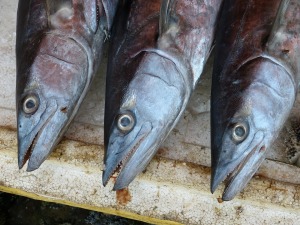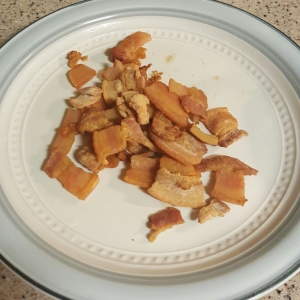
I grew up in southeastern Massachusetts. I’ve heard now that they have some hifalutin name for the area; they call it the “south coast.” Christ. What a lot of marketing nonsense. In the early 1980s nobody used “south coast” for anything. Anyone trying to would probably gotten smacked on principle alone. But that’s where I’m from, anyway.
We were, most of us, half marine-creatures. We raked quahogs (look it up if you don’t know that word); we caught crabs; we fished; and we took our little 75-horsepower motorboats into the bays and crannies off Dartmouth and Westport. I was good with crabs. I would use fish-heads, and tie a line to them by threading a string through the mouth or gills. This would be tossed into shallow water. Within minutes, blue shell crabs would be swarming all over it. You had to reel the fish-head in slowly, slowly, slowly. And then you had to net the crab locked onto it with your free hand. It took practice.
Delicacies to me were clam-cakes, raw quahogs, deep-fried clams, and fish of every variety. But chowder occupied a special place. There was just something about it: cooked on open fires, it would absorb a natural smokiness that was nearly indescribable. In winter it would brighten the spirits and drive off the stillness of the soul. Chowder was a meal unto itself. I never thought of it as a lowly soup.
Certain types of chowders are peculiar to certain regions. The New Yorker will swear by his Manhattan clam chowder, while the New Englander views it with a mixture of scorn and pity. The hardy folk of Maine still retain the knowledge of “building” a chowder in cast-iron pots, layering onion, potatoes, and fish in conscientious proportions.
It was a point of pride that America’s greatest novel (I’m sorry, but it’s a fact), Moby Dick, mentioned New Bedford’s whaling industry in reverential terms. He even devoted an entire chapter to chowder near the beginning of his novel. In the book, Ishmael orders the regal food at his hostel. There are only two choices: clam or cod. That’s it. One or the other. He explains further:
But when that smoking chowder came in, the mystery was delightfully explained. Oh, sweet friends! hearken to me. It was made of small juicy clams, scarcely bigger than hazel nuts, mixed with pounded ship biscuit, and salted pork cut up into little flakes; the whole enriched with butter, and plentifully seasoned with pepper and salt. Our appetites being sharpened by the frosty voyage, and in particular, Queequeg seeing his favorite fishy food before him, and the chowder being surpassingly excellent, we despatched it with great expedition…
Chowder in the old days was very different from what now is considered chowder. Before the 1860s, it had a much larger portion of salt pork than modern tastes would probably enjoy. And salt pork was rather different then than it is now. It was more like “brined” pork: the salting was often done by immersing the pork bellies in wooden barrels of brine. Ship’s biscuit is another one of those nineteenth century foods that few people really know about today. It was basically hard-tack: flour and water were mixed, spread out over baking pans, and fired in an oven to drive off the moisture to form a brick-like product. It was a food staple on long voyages, where regular flour would spoil in the damp and exposure of a ship’s hold.

I will give you my favorite chowder recipe. It’s taken from the most authoritative book on chowders ever written, Jasper White’s 50 Chowders. I consider this book to be the bible of chowder. White is a Boston chef whose knowledge of chowder is literally encyclopedic. His recipe comes from trial and experience, and from diligent research. The first fish chowder recipe, he tells us, appeared in the Boston Evening post in 1751. No dairy products were used in those days: it was basically fish, onions, salt pork, water, and hardtack. But things changed over time; potatoes eventually began to replace hardtack, and cream, milk, and butter would also be added.
Here is my fish chowder recipe. Before we go into the details, let me make a few suggestions.
- The best fish you can use are cod or haddock.
- Haddock is firmer and holds its shape better than cod, but both are fantastic. Don’t cut the fish into pieces that are too small.
- Chowders need to be “cured” or left to rest for a few hours before eating. The flavors need a chance to meld together and form a richer character.
- You need to use fish stock for this recipe. It is made by boiling fish heads and bones. Making it yourself is one option, or you can buy it. Clam juice mixed with water is adequate only if nothing else is available.
- A thick Portuguese bread is good to serve with this chowder
Ingredients
- 4 oz. salt pork. Smoked bacon also works, but some traditionalist cooks advise against it. I like both.
- 2 tbl. spoons unsalted butter
- 2 large onions, diced
- Fresh savory and thyme, chopped, to taste
- 6 bay leaves
- 2 lbs. all-purpose potatoes (I like the skin left on, but some do not)
- 5 cups fish stock
- Salt and pepper to taste.
- 3 lbs. haddock or cod, bones removed
- 1.5 cups half-and-half or heavy cream
- 2 tbl. spoons of parsley and chives
Directions
In a large pot, fry the pork for a few minutes until it becomes a rich brown color. Remove the meat and leave the rendered fat in the pot.

Add the onions, butter, thyme and savory, and bay leaves and saute them for about 5 minutes. Then add the stock and potatoes. Cook the whole mixture until the potatoes are soft. Season with some salt and pepper. I have found that you can add a lot of cracked black pepper to chowder and it will still hold its flavor.
Add the fish and cook everything for another 8 minutes or so. Remove the pot from the heat and let the chowder sit for another ten minutes. Fish in chowder seems to cook very quickly.
Then add the cream and stir the chowder. Don’t stir it too much; you don’t want to break up those nice fish chunks too much.
Chowder very much benefits from being left overnight to “cure.” What happens is something very subtle; all those ingredients combine and integrate with each other to form something very hearty, yet at the same time delicate.
The chowder should be served as if it is a meal unto itself (which it is). Use large soup bowls centered on a dish, and spread oyster crackers (or ship’s biscuit) around the bowl. Don’t forget to add the pork cracklings. Take them out and reheat them in the oven for a few minutes, then sprinkle them over the chowder bowls. Add the parsley and chives.

It is possible to add clams to this recipe for a little variety, but I prefer to keep my fish and clams separate. A future article will deal with clam chowder. Until then, eat well. There are few better ways of warding off the winter chill than getting some good chowder down your gullet.
Read more about this and related subjects in Pantheon.

You must be logged in to post a comment.